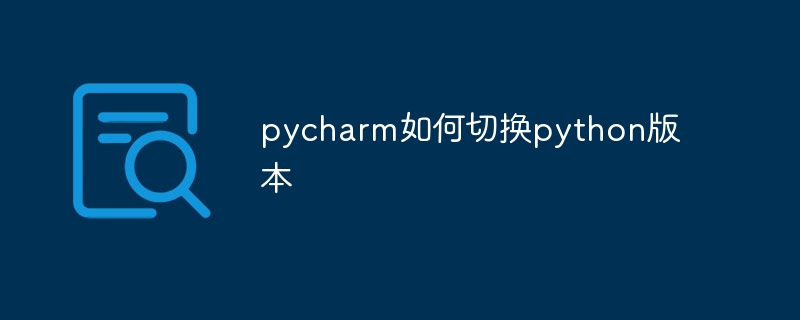 Backend Development
Backend Development Python Tutorial
Python Tutorial A magical tool to improve code comment efficiency: make PyCharm your first choice
A magical tool to improve code comment efficiency: make PyCharm your first choice
PyCharm comment artifact: Make code comments easy and efficient
Introduction: Code comments are an indispensable part of program development, whether it is to facilitate code reading , collaborative development, or to facilitate subsequent code maintenance and debugging. In Python development, the PyCharm annotation artifact brings us a convenient and efficient code annotation experience. This article will introduce the functions and usage of PyCharm annotation artifact in detail, and demonstrate it with specific code examples.
1. Functions of PyCharm comment artifact
PyCharm is a powerful Python integrated development environment. Its built-in comment function allows us to easily add and manage code comments. The following are the main functions of the PyCharm comment artifact:
- Automatically generate function comments: When writing a function, PyCharm can automatically generate function comments based on the function's parameters and return value types, eliminating the need to manually write comments step.
- Quickly generate annotation templates: PyCharm provides the function of quickly generating annotation templates, which can automatically generate basic annotation templates for functions or classes, including documentation strings, parameter descriptions, return value descriptions, etc.
- Quick comment/uncomment: PyCharm provides shortcut keys to quickly comment or uncomment selected lines or blocks of code.
- Batch comments: PyCharm also supports batch commenting or uncommenting of multiple lines of code, eliminating the tedious step of commenting line by line.
- Comment tips: When writing code, PyCharm will provide automatic completion and parameter prompt functions for functions or methods based on existing comments, which greatly improves the efficiency of code writing.
2. How to use the PyCharm annotation artifact
Next, we will demonstrate the use of the PyCharm annotation artifact through specific code examples.
- Automatically generated function comments:
def add(a, b):
"""
Add two numbers together and return the sum.
:param a: The first number.
:param b: The second number.
:return: The sum of a and b.
"""
return a + bIn the above example, we defined a function named add and added an automatically generated function comment above the function , which details the parameters and return values of the function.
- Quickly generate annotation templates:
class Circle:
def __init__(self, radius):
"""
Initialize a circle object.
:param radius: The radius of the circle.
"""
self.radius = radius
def get_area(self):
"""
Calculate the area of the circle.
:return: The area of the circle.
"""
return 3.14 * self.radius ** 2In the above example, we defined a class named Circle and generated the class by quickly generating annotation templates. Comments include documentation strings and method parameter and return value descriptions.
- Quick comment/uncomment:
We can quickly comment or uncomment the selected line or code block through the shortcut key Ctrl / or Command / (Mac) .
- Batch comments:
We can quickly comment on the selected lines by selecting multiple lines of code and then using the shortcut key Ctrl Shift / or Command Shift / (Mac) code.
- Comment tips:
When writing a function or method, PyCharm will provide automatic completion and parameter prompt functions for the function or method based on existing comments. You can display parameter information for a function by typing the parentheses after the function name and pressing Ctrl P (Windows) or Command P (Mac).
Conclusion:
The PyCharm comment artifact greatly simplifies the process of code comments and provides a series of powerful functions to help us write and manage code comments more efficiently. Through the introduction and example demonstration of this article, I believe that everyone has an understanding of how to use the PyCharm annotation artifact. I hope it will be helpful to your Python development work!
The above is the detailed content of A magical tool to improve code comment efficiency: make PyCharm your first choice. For more information, please follow other related articles on the PHP Chinese website!
 如何解决pycharm找不到模块Dec 04, 2023 pm 01:31 PM
如何解决pycharm找不到模块Dec 04, 2023 pm 01:31 PM解决pycharm找不到模块的方法:1、检查python解释器;2、安装缺失的模块;3、检查项目结构;4、检查系统路径;5、使用虚拟环境;6、重启PyCharm或电脑。PyCharm找不到模块是一个常见的问题,但通常可以通过一些步骤来解决,这个问题可能由多种原因引起,比如Python解释器配置不正确、模块没有正确安装或者PyCharm的项目设置有问题。
 pycharm打不开怎么办Dec 07, 2023 pm 05:09 PM
pycharm打不开怎么办Dec 07, 2023 pm 05:09 PMpycharm打不开可以通过检查系统要求、重新启动计算机、检查防病毒软件和防火墙设置、检查日志文件、更新PyCharm、检查系统环境变量、重置PyCharm设置、检查日志文件和报错信息、卸载并重新安装PyCharm和向PyCharm官方支持寻求帮助来解决。详细介绍:1、检查系统要求,确保计算机满足PyCharm的最低系统要求;2、重新启动计算机等等。
 pycharm怎么批量替换Dec 07, 2023 pm 05:27 PM
pycharm怎么批量替换Dec 07, 2023 pm 05:27 PMpycharm可以通过使用搜索和替换功能、结合正则表达式进行高级替换、使用代码重构功能、使用Structural Search and Replace和导入外部工具进行批量替换来批量替换。详细介绍:1、使用搜索和替换功能,打开PyCharm,打开要进行批量替换的项目或文件夹等等。
 pycharm注释快捷键有哪些Dec 05, 2023 pm 02:14 PM
pycharm注释快捷键有哪些Dec 05, 2023 pm 02:14 PMpycharm注释快捷键有:1、单行注释,使用“#”;2、多行注释,使用三引号“””;3、批量注释,选择要注释的文本行,背景变化后,同时按“Ctrl+/”;4、取消批量注释,选择已注释的文本行,背景变化后,同时按“Ctrl+/”;5、批量缩进,选择要缩进的文本行,背景变化后,按下“TAB”键;6、取消批量缩进,选择要缩进的文本行,背景变化后,按下“SHIFT+TAB”键。
 pycharm怎样改变背景颜色Dec 07, 2023 pm 04:58 PM
pycharm怎样改变背景颜色Dec 07, 2023 pm 04:58 PMpycharm改变背景颜色的方法:1、使用主题设置,在PyCharm设置对话框中,选择 "Editor",选择喜欢的主题,点击 "Apply"即可;2、使用自定义背景颜色,在 "Editor"选项卡中,点击"Background",选择喜欢的颜色,确认即可;3、使用快捷键快速更改背景颜色,按下 "Ctrl+Alt+S" 组合键打开设置对话框,跟上面一样选择型号的颜色即可等等。
 pycharm如何切换python版本Dec 08, 2023 pm 02:14 PM
pycharm如何切换python版本Dec 08, 2023 pm 02:14 PMpycharm切换python版本的方法:1、通过项目配置,在“New Project”或“Open”对话框中,可以指定Python解释器的版本;2、使用虚拟环境,虚拟环境为每个项目提供了一个隔离的Python环境,可以在不影响其他项目的情况下更改和升级库和依赖项;3、使用系统环境变量,可以添加一个新的系统环境变量,指向使用的Python解释器的路径;4、使用第三方插件等等。
 pycharm和python有什么区别Dec 04, 2023 pm 04:26 PM
pycharm和python有什么区别Dec 04, 2023 pm 04:26 PMpycharm和python区别是:1、PyCharm是一款软件开发工具,而Python则是一种编程语言;2、PyCharm提供了丰富的功能和工具,而Python本身提供了各种库和模块;3、PyCharm主要用于编写、调试和运行Python代码,而Python语言可以应用于各种开发场景等等。
 pycharm快捷键大全Dec 04, 2023 pm 04:39 PM
pycharm快捷键大全Dec 04, 2023 pm 04:39 PMpycharm快捷键有:1、Ctrl + C,复制选定的文本;2、Ctrl + X,剪切选定的文本;3、Ctrl + V,粘贴剪切板上的文本;4、Ctrl + Z:撤销上一次操作;5、Ctrl + Y:重做上一次取消的操作;6、Ctrl + D:复制当前行或选中的部分,并将其插入到下一行;7、Tab:缩进选中的代码;8、Shift + Tab:取消缩进选中的代码等等。


Hot AI Tools

Undresser.AI Undress
AI-powered app for creating realistic nude photos

AI Clothes Remover
Online AI tool for removing clothes from photos.

Undress AI Tool
Undress images for free

Clothoff.io
AI clothes remover

AI Hentai Generator
Generate AI Hentai for free.

Hot Article

Hot Tools

SublimeText3 Mac version
God-level code editing software (SublimeText3)

MinGW - Minimalist GNU for Windows
This project is in the process of being migrated to osdn.net/projects/mingw, you can continue to follow us there. MinGW: A native Windows port of the GNU Compiler Collection (GCC), freely distributable import libraries and header files for building native Windows applications; includes extensions to the MSVC runtime to support C99 functionality. All MinGW software can run on 64-bit Windows platforms.

Atom editor mac version download
The most popular open source editor

Dreamweaver CS6
Visual web development tools

VSCode Windows 64-bit Download
A free and powerful IDE editor launched by Microsoft




